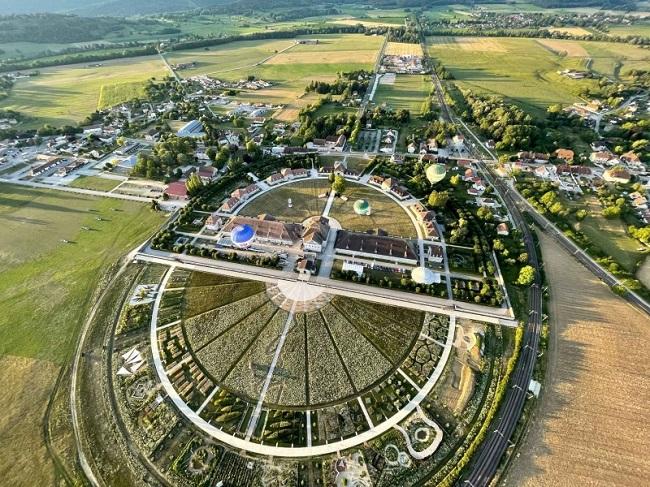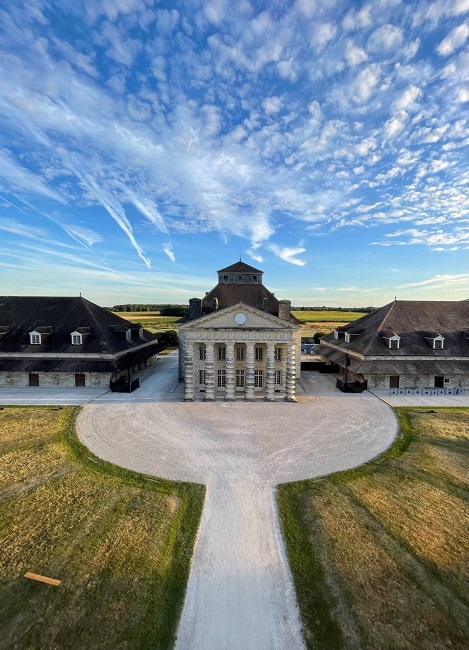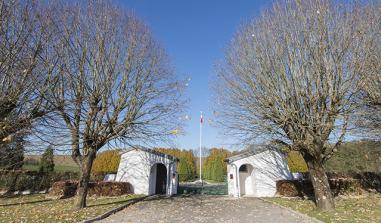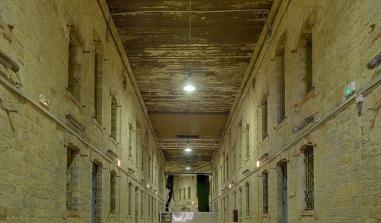Saline royale d'Arc et Senans

Vue panoramique. Source : http://www.salineroyale.com/
The Royal Saltworks of Arc-et-Senans, the architectural masterpiece of Claude-Nicolas Ledoux, was used as an internment camp for Gypsies...
Internment of the Gypsies
In May 1941, the Feldkommandantur for Besançon decided to apply the decree passed on 4th October 1940 forcing travelling people in the occupied zone to be held together in internment camps. This measure was initially aimed at those in the Belfort, Doubs, Haute-Saône and Jura areas. It was then extended to cover those in the Côte-d'Or, Haute-Marne, Saône-et-Loire and Ain Departements. Thus, on 24th June 1941, the first travellers from Belfort were sent to the Châtelain and Châtelaine forest houses belonging to the Chaux estate, 22 km from Dôle. But this location quickly proved unsuitable. Insufficient accommodation and water that was unfit to drink caused the German authorities to transfer the Gypsies to the Arc-et-Senans Saltworks on 1st September 1941.
Built by architect Claude Nicolas LEDOUX, and owned by the Doubs Departement since 1927, the Royal Saltworks at that time was in a very poor state of repair despite initial restoration work carried out between 1930 and 1936. Among other things it had already been used as an assembly centre for Spanish Republicans between February and October 1939, before being requisitioned by the French Army during the Phoney War. The Germans then took possession of the place during the first half of 1941, until their departure. Until 15th May 1942, the status of the Arc-et-Senans camp, run by four Customs Officers, was that of an assembly centre. In effect, this meant that the Gypsies, grouped into whole families, could leave the camp area, through the use of exit passes. This period was also notable for the absence of common buildings which meant that the travelling people had to live by their own means. Thus, in order to support their families, some adults went to work in neighbouring businesses such as engineering firm UMAS (Union métallurgique d'Arc-et-Senans) or the Todt organisation. In addition, the sanitation was appalling; the showers were unusable, the toilets did not work and there were inadequate fresh water supplies... The lack of hygiene gave rise to diseases such as scabies, and many gypsies had to be transferred to the hospitals in Besançon for treatment. Meanwhile, an excessive number of escapes and exit passes that were too freely issued led to many complaints from the inhabitants of Arc-et-Senans. And on 15th May 1942, the order was given for the Royal Saltworks to become an internment camp. The changes were radical; people were no longer permitted to leave and as a result some hitherto absent facilities were rapidly installed. These included soup-kitchen style catering facilities, as well as an infirmary and a school able to take the 58 children registered at the camp. Despite these transformations, the Gypsy population still lived in difficult conditions. A report issued by the Camp Governor in August 1943, revealed that of the 185 internees, 44 suffered from skin complaints: infected wounds, abscesses, varicose ulcers, etc. Furthermore, the escapes continued. This undoubtedly led to the closure of the camp at Arc-et-Senans on 11th September 1943 and the transfer of the Gypsy families to the Jargeau internment camp in the Loiret region. This dramatic episode in the history of the Royal Saltworks has not been forgotten. On 11th and 12th March 1999 - as part of a major event entitled "A Look at Travelling People", organised by the Institut Claude Nicolas LEDOUX - a seminar was held at the Royal Saltworks on the theme "The Arc-et-Senans internment camp: its part in the discriminatory treatment of Gypsies". Finally, on 9th April 1999, a commemorative plaque was placed at the entrance to the Saltworks in tribute to the interned families.
Saline Royale Institut Claude-Nicolas Ledoux Département Tourisme et Publics 25610 Arc et Senans Tél.: + 33 (0)3 81 54 45 45 Fax: + 33 (0)3 81 54 45 46

The Director's house. Photo Vincent Konsler
Practical information
Avenue de la Saline 25610
Arc et Senans
03 81 54 45 45
Adulte: 7,5 € Jeunes de 16 à 25 ans: 5 € Enfants de 6 à 15 ans: 3,5 € Gratuit : Enfant (- de 6 ans)
De novembre à mars: 10h à 12h et 14h à17h Avril, mai, octobre: 9h à 12h et 14h à 18h Juin et septembre: 9h à 18h Juillet et Août: 9h à 19h
Fermé le 25 décembre et le 1er janvier





